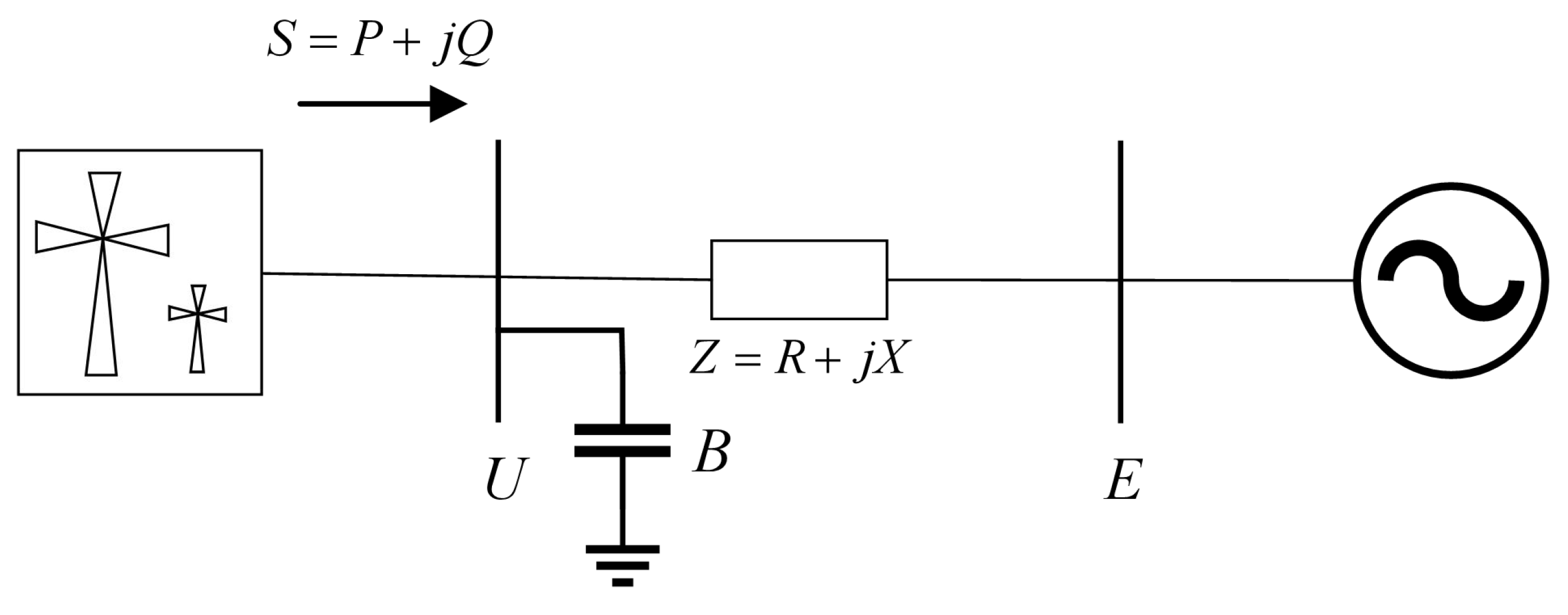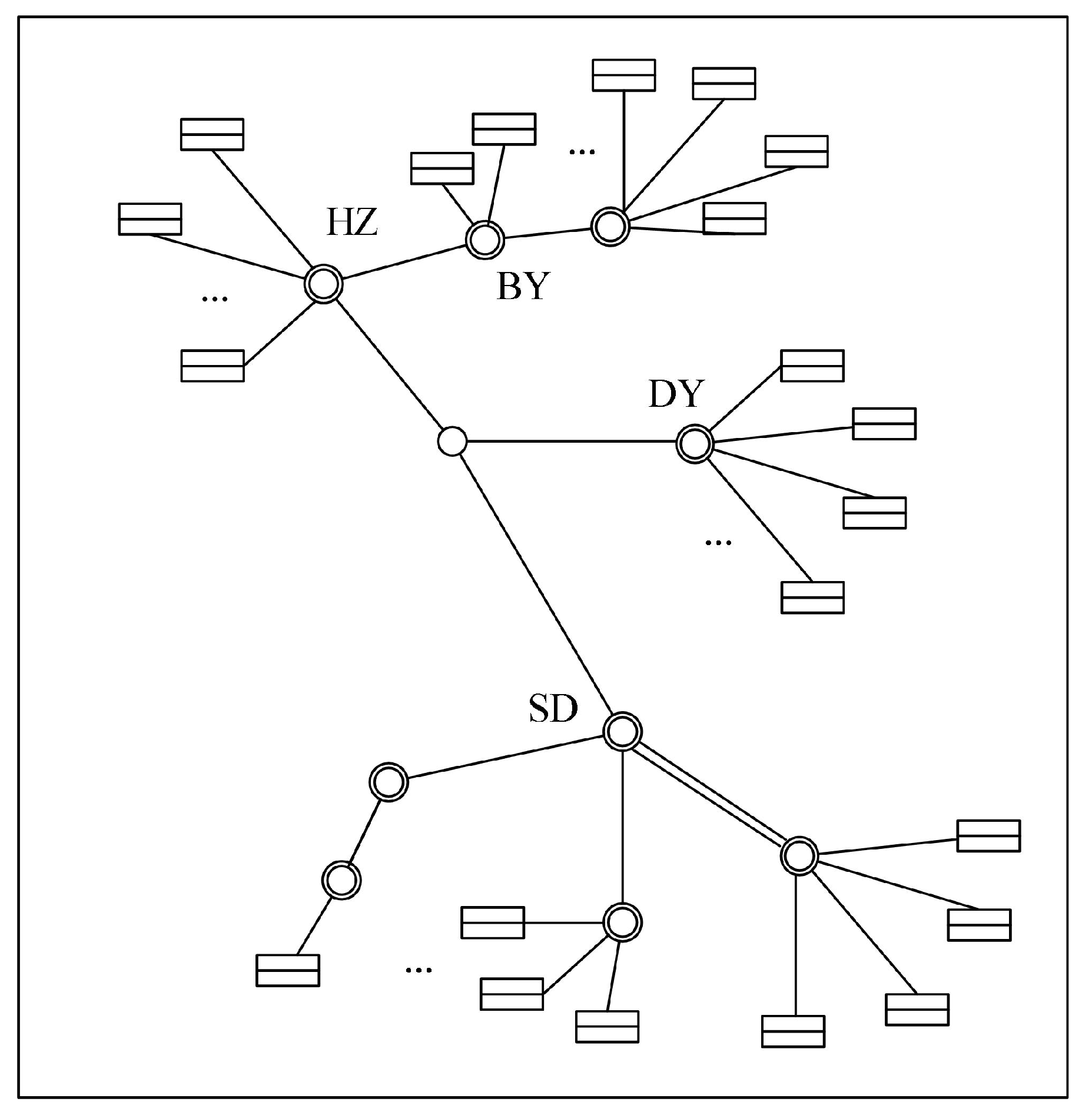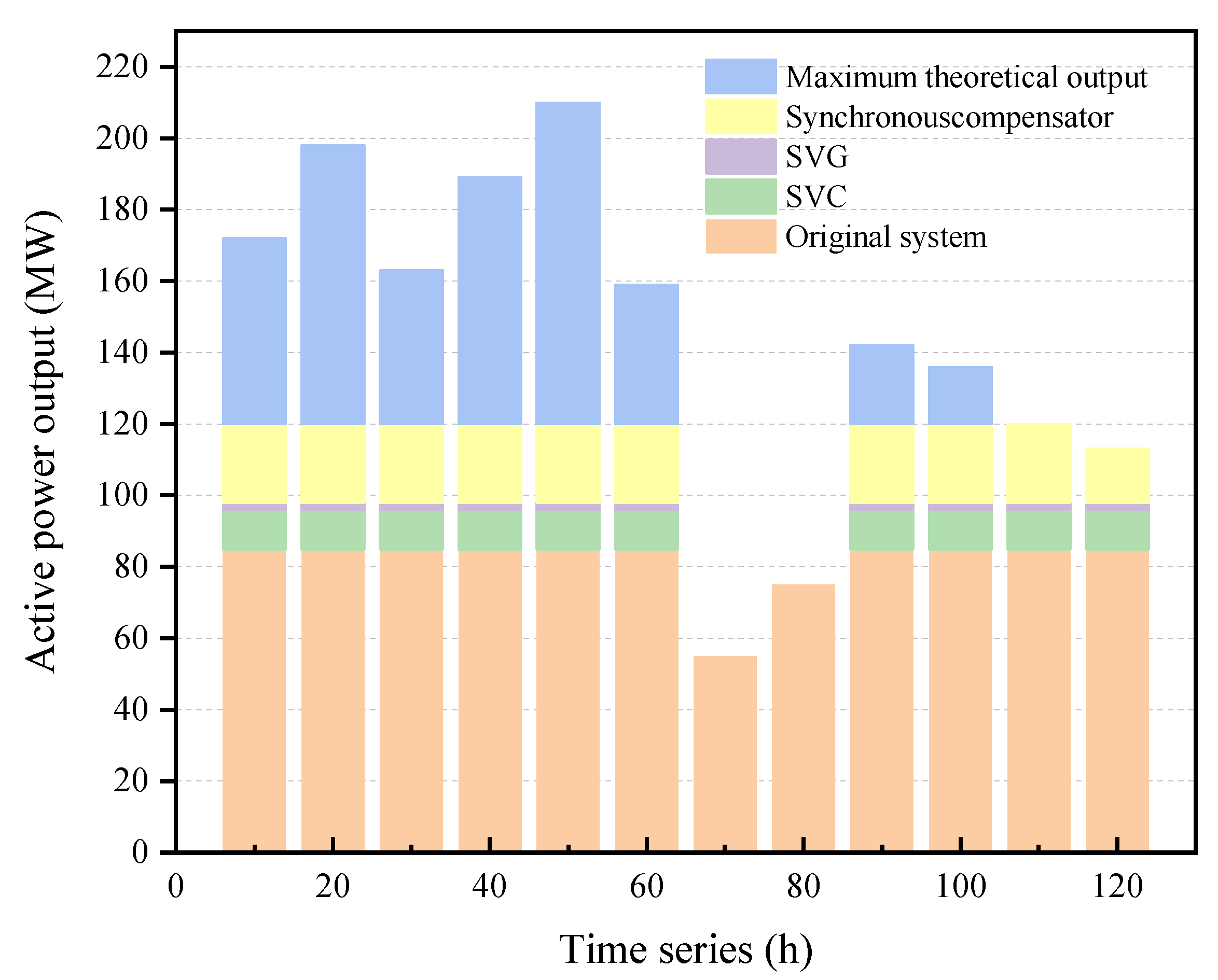Assessment of Grid-Tied Renewable Energy Systems’ Voltage Support Capability Under Various Reactive Power Compensation Devices
Abstract
1. Introduction
2. Voltage Support Strength Enhancement Mechanisms in Renewable Grid-Connected Systems Under Diverse Compensation Devices
2.1. Static Var Compensator Enhancement Mechanism
2.2. Static Var Generator Enhancement Mechanism
2.3. Synchronous Condenser Enhancement Mechanism
3. Quantitative Assessment of Voltage Support Strength in Grid-Connected Renewable Energy Stations
3.1. Short-Circuit Ratio Index for Voltage Support Strength of Renewable Energy Power Stations Under Reactive Power Compensation
3.2. Calculation Method of CSCR for Renewable Power Stations with Reactive Compensators
3.3. Quantitative Analysis of Voltage Support Strength in Grid-Tied Renewable Energy Stations
- When , or , the developed renewable power grid-connected system for the single-feed system is unstable. The stability margin increases with system instability; a system is in a stable condition when , which means . The stability margin increases with system security.
- In the case of the new energy multi-feed system, when , meaning that , the system is unstable; the more unstable the system, the larger the stability margin ; when , meaning that , the system is stable; the more stable the system, the larger the stability margin .
4. Example Analysis
4.1. Stability Assessment of the System After Reactive Power Compensation
4.2. Comparative Analysis of Renewably Constructed Energy System Stability Under Different Reactive Power Compensation Devices
5. Conclusions
- Reactive power compensation is analyzed, and equations for the appropriate SCR and CSCR are derived while fully accounting for the impact of actual operating factors. Based on the SCR calculation procedure, the specific effects of each reactive power compensation technique on SCR computation are examined in detail. Subsequently, the influence of each reactive power compensation method on the increased energy consumption capacity is thoroughly explored. A reliability margin is introduced to quantitatively assess the system’s security levels comprehensively. Example results verify the accuracy and practical effectiveness of the proposed methods.
- The example results clearly demonstrate that all three reactive power compensation devices influence voltage support capacity. Among them, the synchronous condenser has the most significant impact on voltage support strength; it directly modifies the self-admittance of the access point, thereby effectively increasing the node’s MRSCR value substantially.
- The stability margin of the short-circuit ratio (SCR) is a crucial indicator for assessing the capacity of power systems to integrate renewable energy. It defines the additional capacity that can be accommodated by renewable energy sources while ensuring the stable operation of the system. This surplus capacity is directly related to the increase in the system’s transferable power capacity. The higher the stability margin, the greater the amount of renewable energy that the system can transmit through the transmission network without exceeding stability limits. Consequently, the stability margin of the SCR not only provides a quantitative basis for evaluating the acceptance capacity of existing systems for renewable energy but also serves as an important reference for engineering practices. This includes determining the appropriate scale for new energy grid connections during the planning phase, optimizing grid topology, and configuring reactive power compensation.
Author Contributions
Funding
Data Availability Statement
Conflicts of Interest
References
- Shi, Z.; Wang, W.; Huang, Y.; Li, P.; Dong, L. Simultaneous optimization of renewable energy and energy storage capacity with the hierarchical control. CSEE J. Power Energy Syst. 2022, 8, 95–104. [Google Scholar]
- Echevarria, A.; Rivera-Matos, Y.; Irshad, N.; Gregory, C.; Castro-Sitiriche, M.J.; King, R.R.; Miller, C.A. Unleashing Sociotechnical Imaginaries to Advance Just and Sustainable Energy Transitions: The Case of Solar Energy in Puerto Rico. IEEE Trans. Technol. Soc. 2023, 4, 255–268. [Google Scholar] [CrossRef]
- Ye, C.; Jiang, K.; Liu, D.; Zhang, C.; Zhang, D.; Liu, Z. Emergency Control Strategy for High Proportion Renewable Power System Considering the Frequency Aggregation Response of Multi-Type Power Generations. IEEE Access 2024, 12, 188325–188335. [Google Scholar] [CrossRef]
- Han, P.; Li, P.; Xie, X.; Zhang, J. Coordinated Optimization of Power Rating and Capacity of Battery Storage Energy System with Large-Scale Renewable Energy. In Proceedings of the 2022 IEEE 6th Conference on Energy Internet and Energy System Integration (EI2), Chengdu, China, 11–13 November 2022; pp. 189–193. [Google Scholar]
- Huang, Y.; Wang, Y.; Li, C.; Zhao, H.; Wu, Q. Physics Insight of the Inertia of Power Systems and Methods to Provide Inertial Response. CSEE J. Power Energy Syst. 2022, 8, 559–568. [Google Scholar] [CrossRef]
- Hossain, M.I.; Hamanah, W.M.; Alam, M.S.; Shafiullah, M.; Abido, M.A. Fault Ride Through and Intermittency Improvement of Renewable Energy Integrated MMC-HVDC System Employing Flywheel Energy Storage. IEEE Access 2023, 11, 50528–50546. [Google Scholar] [CrossRef]
- Li, X.; Wang, S. Energy management and operational control methods for grid battery energy storage systems. CSEE J. Power Energy Syst. 2021, 7, 1026–1040. [Google Scholar]
- Lai, J.; Chen, M.; Dai, X.; Zhao, N. Energy Management Strategy Adopting Power Transfer Device Considering Power Quality Improvement and Regenerative Braking Energy Utilization for Double-Modes Traction System. CPSS Trans. Power Electron. Appl. 2022, 7, 103–111. [Google Scholar] [CrossRef]
- Yu, L.; Xu, S.; Sun, H.; Zhao, B.; Wu, G.; Zhou, X. Multiple Renewable Short-Circuit Ratio for Assessing Weak System Strength with Inverter-Based Resources. CSEE J. Power Energy Syst. 2024, 10, 2271–2282. [Google Scholar]
- Wang, G.; Xin, H.; Wu, D.; Li, Z.; Ju, P. Grid Strength Assessment for Inhomogeneous Multi-infeed HVDC Systems via Generalized Short Circuit Ratio. J. Mod. Power Syst. Clean Energy 2023, 11, 1370–1374. [Google Scholar] [CrossRef]
- Bennett, M.; Nassif, A.; Rahmatian, M.; Liu, Y.; Jiang, Z.; Gevorgian, V.; Fan, X.; Elizondo, M. Grid Strength Assessment for High Levels of Inverter-based Resources in the Puerto Rico Power System. In Proceedings of the 2023 IEEE PES Innovative Smart Grid Technologies Latin America (ISGT-LA), San Juan, PR, USA, 6–9 November 2023. [Google Scholar]
- Bryant, J.S.; McGrath, B.; Meegahapola, L.; Sokolowski, P. Small-Signal Stability Analysis of Voltage Source Inverters Operating under Low Short-Circuit Ratios. In Proceedings of the 2021 IEEE Madrid PowerTech, Madrid, Spain, 28 June–2 July 2021. [Google Scholar]
- Darbandi, A.F.; Sinkar, A.; Gole, A. Effect of Short-Circuit Ratio and Current Limiting on the Stability of a Virtual Synchronous Machine Type Gridforming Converter. In Proceedings of the 17th International Conference on AC and DC Power Transmission (ACDC 2021), Online, 7 July–8 December 2021. [Google Scholar]
- Yamada, Y.; Tsusaka, A.; Nanahara, T.; Yukita, K. A Study on Short-Circuit-Ratio for an Inverter-Based Resource with Power-Voltage Curves. IEEE Trans. Power Syst. 2024, 39, 6076–6086. [Google Scholar] [CrossRef]
- Lee, G.-S.; Hwang, P.-I.; Moon, S.-I. Reactive Power Control of Hybrid Multi-Terminal HVDC Systems Considering the Interaction Between the AC Network and Multiple LCCs. IEEE Trans. Power Syst. 2021, 36, 4562–4574. [Google Scholar] [CrossRef]
- Wang, Y.; Wang, L.; Jiang, Q. Impact of Synchronous Condenser on Sub/Super-Synchronous Oscillations in Wind Farms. IEEE Trans. Power Deliv. 2021, 36, 2075–2084. [Google Scholar] [CrossRef]
- Wang, H.; Chen, Q.; Zhang, L.; Yin, X.; Zhang, Z.; Wei, H.; Chen, X. Research and Engineering Practice of Var-Voltage Control in Primary and Distribution Networks Considering the Reactive Power Regulation Capability of Distributed PV Systems. Energies 2025, 18, 2135. [Google Scholar] [CrossRef]
- Wei, L.; Yang, B.; Lu, S. A VSG Power Decoupling Control with Integrated Voltage Compensation Schemes. Energies 2025, 18, 1878. [Google Scholar] [CrossRef]
- Ch, S.S.; Hredzak, B.; Farhangi, M.; Prasad, R.; Kumar, D.M.; Fagiolini, A.; Di Benedetto, M.; Mudaliar, H.K.; Cirrincione, M. Adaptive Control of Grid-Following Inverter-Based Resources Under Low Network Short Circuit Ratio. IEEE Trans. Ind. Appl. 2025, 61, 1828–1838. [Google Scholar]
- Gong, C.; Sou, W.-K.; Lam, C.-S. H∞ optimal control design of static var compensator coupling hybrid active power filter based on harmonic state-space modeling. CPSS Trans. Power Electron. Appl. 2021, 6, 227–234. [Google Scholar] [CrossRef]
- Chakraborty, S.; Mukhopadhyay, S.; Biswas, S.K. Coordination of D-STATCOM & SVC for Dynamic VAR Compensation and Voltage Stabilization of an AC Grid Interconnected to a DC Microgrid. IEEE Trans. Ind. Appl. 2022, 58, 634–644. [Google Scholar]
- Gao, H.; Huang, Z.; Diao, R.; Zhang, J.; Hou, B.; Wu, C.; Sun, F.; Lan, T. A Machine Learning-Based SVG Parameter Identification Framework Using Hardware-in-the-Loop Testbed. IEEE Trans. Power Syst. 2024, 39, 6849–6860. [Google Scholar] [CrossRef]
- Gao, H.; Diao, R.; Huang, Z.; Zhong, Y.; Mao, Y.; Tang, W. Parameter Identification of SVG Using Multilayer Coarse-to-Fine Grid Searching and Particle Swarm Optimization. IEEE Access 2022, 10, 77137–77146. [Google Scholar] [CrossRef]
- Tian, X.; Chi, Y.; Li, Y.; Tang, H.; Liu, C.; Su, Y. Coordinated damping optimization control of sub-synchronous oscillation for DFIG and SVG. CSEE J. Power Energy Syst. 2021, 7, 140–149. [Google Scholar]
- Ren, L.; Wang, F.; Shi, Y.; Gao, L. Coupling Effect Analysis and Design Principle of Repetitive Control Based Hybrid Controller for SVG with Enhanced Harmonic Current Mitigation. IEEE J. Emerg. Sel. Top. Power Electron. 2022, 10, 5659–5669. [Google Scholar] [CrossRef]
- Nair, A.R.; Patel, S.; Kamalasadan, S.; Smith, M.; Siddiqui, S. Parametrically Optimized Synchronous Condenser Coordinated Control Framework to Enhance Bulk Grid Stability with Renewables. IEEE Trans. Ind. Appl. 2024, 60, 5737–5750. [Google Scholar] [CrossRef]
- Tan, J.; Xue, R.; Tan, H.; Zhang, T.; Zhao, Y.; Zhao, B.; Wu, S.; Zhai, Y.; Dang, H. Design and Experimental Investigations on the Helium Circulating Cooling System Operating at Around 20 K for a 300-kvar Class HTS Dynamic Synchronous Condenser. IEEE Trans. Appl. Supercond. 2022, 32, 1–5. [Google Scholar] [CrossRef]
- Hadavi, S.; Mansour, M.Z.; Bahrani, B. Optimal Allocation and Sizing of Synchronous Condensers in Weak Grids with Increased Penetration of Wind and Solar Farms. IEEE J. Emerg. Sel. Top. Circuits Syst. 2021, 11, 199–209. [Google Scholar] [CrossRef]
- Sanni, S.O.; Mohammed, O.O.; Chakraborty, S.; Abdullateef, A.I.; Otuoze, A.O.; Ikotun, O.; Agyekum, E.B. On the Choice of System Strength Metrics for the Allocation and Sizing of Synchronous Condensers in Power Grids. IEEE Access 2025, 13, 83781–83793. [Google Scholar] [CrossRef]
- Liu, X.; Xin, H.; Zheng, D.; Chen, D.; Tu, J. Transient Stability of Synchronous Condenser Co-Located with Renewable Power Plants. IEEE Trans. Power Syst. 2024, 39, 2030–2041. [Google Scholar] [CrossRef]
- Han, C.; Shang, L.; Su, S.; Dong, X.; Wang, B.; Bai, H.; Li, W. Grid Synchronization Control for Grid-Connected Voltage Source Converters Based on Voltage Dynamics of DC-Link Capacitor. J. Mod. Power Syst. Clean Energy 2024, 12, 1678–1689. [Google Scholar] [CrossRef]
- Liu, T.; Wang, P.; Ma, J.; Zhang, R.; Wang, S.; Wu, Z.; Wang, R. Presynchronization Control for Grid-Connected Inverters Without Grid Voltage Sensors. IEEE Trans. Power Electron. 2023, 38, 2833–2838. [Google Scholar] [CrossRef]
- Vaidya, S.; Prasad, K.; Kilby, J. The Role of Multilevel Inverters in Mitigating Harmonics and Improving Power Quality in Renewable-Powered Smart Grids: A Comprehensive Review. Energies 2025, 18, 2065. [Google Scholar] [CrossRef]
- Wang, Z.; Zeng, X.; Li, Z.; Yu, K.; Wu, C.; Jiang, Z.; Zhuo, C. An Active Voltage-Type Grounding Fault Protection Method for Medium-Voltage Distribution Networks with Neutral Point Voltage Flexible Regulation. IEEE Trans. Power Deliv. 2024, 39, 1538–1548. [Google Scholar] [CrossRef]
- Miao, W.; Xu, Q.; Lam, K.H.; Pong, P.W.T.; Poor, H.V. DC Arc-Fault Detection Based on Empirical Mode Decomposition of Arc Signatures and Support Vector Machine. IEEE Sensors J. 2021, 21, 7024–7033. [Google Scholar] [CrossRef]
- Wang, G.; Huang, Y.; Xu, Z. Voltage Stiffness for Strength Evaluation of VSC-Penetrated Power Systems. IEEE Trans. Power Syst. 2024, 39, 6119–6122. [Google Scholar] [CrossRef]
- Yu, L.; Sun, H.; Xu, S.; Zhao, B.; Zhang, J. A Critical System Strength Evaluation of a Power System with High Penetration of Renewable Energy Generations. CSEE J. Power Energy Syst. 2022, 8, 710–720. [Google Scholar]
- Abbass, M.J.; Lis, R.; Rebizant, W. Advanced Voltage Stability Assessment in Renewable-Powered Islanded Microgrids Using Machine Learning Models. Energies 2025, 18, 2047. [Google Scholar] [CrossRef]
- Sadek, S.M.; Omran, W.A.; Hassan, M.A.M.; Talaat, H.E.A. Data Driven Stochastic Energy Management for Isolated Microgrids Based on Generative Adversarial Networks Considering Reactive Power Capabilities of Distributed Energy Resources and Reactive Power Costs. IEEE Access 2021, 9, 5397–5411. [Google Scholar] [CrossRef]
- Feng, N.; Feng, Y.; Su, Y.; Zhang, Y.; Niu, T. Dynamic Reactive Power Optimization Strategy for AC/DC Hybrid Power Grid Considering Different Wind Power Penetration Levels. IEEE Access 2024, 12, 187471–187482. [Google Scholar] [CrossRef]
- Liang, W.; Liu, Y.; Peng, J. A Day and Night Operational Quasi-Z Source Multilevel Grid-Tied PV Power System to Achieve Active and Reactive Power Control. IEEE Trans. Power Electron. 2021, 36, 474–492. [Google Scholar] [CrossRef]
- Al Farisi, F.K.; Fan, Z.-K.; Lian, K.-L. Comparative Study of White Shark Optimization and Combined Meta-Heuristic Algorithm for Enhanced MPPT in Photovoltaic Systems. Energies 2025, 18, 2110. [Google Scholar] [CrossRef]
- Wang, B.; Tian, Z.; Yang, H.; Li, C.; Xu, X.; Zhu, S.; Du, E.; Zhang, N. Collaborative Planning of Source–Grid–Load–Storage Considering Wind and Photovoltaic Support Capabilities. Energies 2025, 18, 2045. [Google Scholar] [CrossRef]









| AC System Impedance | Branch 1 | Branch 2 | Branch 3 |
|---|---|---|---|
| Node | MRSCR | CSCR | ||
|---|---|---|---|---|
| 1 | 2.085 | 2.055 | 1.46% | |
| 2 | 1.893 | 1.891 | 0.11% | |
| 3 | 1.893 | 1.891 | 0.11% | |
| 1 | 2.008 | 1.852 | 8.42% | |
| 2 | 1.817 | 1.803 | 0.78% | |
| 3 | 1.817 | 1.803 | 0.78% | |
| 1 | 1.911 | 1.663 | 14.91% | |
| 2 | 1.723 | 1.697 | 1.53% | |
| 3 | 1.723 | 1.697 | 1.53% |
| Renewable Energy Power Plant | Original System | SVC | SVG | Synchronous Compensator |
|---|---|---|---|---|
| SD | 1.806 | 1.851 | 1.951 | 2.474 |
| DY | 1.880 | 1.948 | 2.128 | 3.005 |
| HZ | 1.981 | 2.041 | 2.137 | 3.126 |
| BY | 1.874 | 1.909 | 2.072 | 3.183 |
Disclaimer/Publisher’s Note: The statements, opinions and data contained in all publications are solely those of the individual author(s) and contributor(s) and not of MDPI and/or the editor(s). MDPI and/or the editor(s) disclaim responsibility for any injury to people or property resulting from any ideas, methods, instructions or products referred to in the content. |
© 2025 by the authors. Licensee MDPI, Basel, Switzerland. This article is an open access article distributed under the terms and conditions of the Creative Commons Attribution (CC BY) license (https://creativecommons.org/licenses/by/4.0/).
Share and Cite
Cao, J.; Liu, M.; Ma, Q.; Fan, J.; Song, D.; Zhou, X.; Dai, J.; Wu, H. Assessment of Grid-Tied Renewable Energy Systems’ Voltage Support Capability Under Various Reactive Power Compensation Devices. Energies 2025, 18, 3880. https://doi.org/10.3390/en18143880
Cao J, Liu M, Ma Q, Fan J, Song D, Zhou X, Dai J, Wu H. Assessment of Grid-Tied Renewable Energy Systems’ Voltage Support Capability Under Various Reactive Power Compensation Devices. Energies. 2025; 18(14):3880. https://doi.org/10.3390/en18143880
Chicago/Turabian StyleCao, Jie, Mingshun Liu, Qinfeng Ma, Junqiu Fan, Dongkuo Song, Xia Zhou, Jianfeng Dai, and Hao Wu. 2025. "Assessment of Grid-Tied Renewable Energy Systems’ Voltage Support Capability Under Various Reactive Power Compensation Devices" Energies 18, no. 14: 3880. https://doi.org/10.3390/en18143880
APA StyleCao, J., Liu, M., Ma, Q., Fan, J., Song, D., Zhou, X., Dai, J., & Wu, H. (2025). Assessment of Grid-Tied Renewable Energy Systems’ Voltage Support Capability Under Various Reactive Power Compensation Devices. Energies, 18(14), 3880. https://doi.org/10.3390/en18143880





